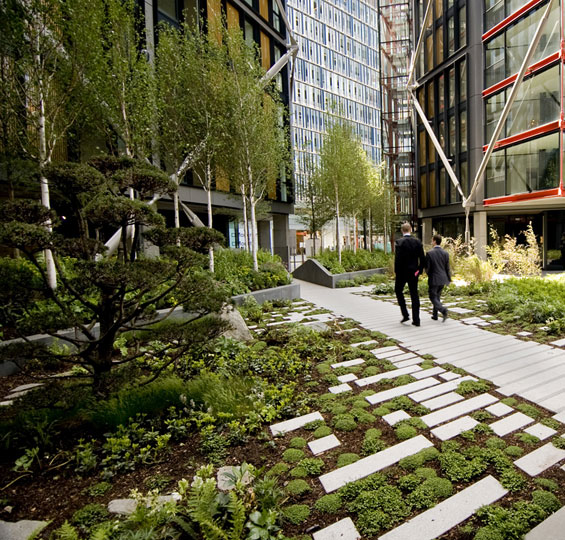
Paralleling the opening of London’s luxury NEO Bankside development next to the Tate Modern is the unveiling of a new city-centre green landscape. At NEO Bankside, Gillespies has created a series of richly-detailed garden spaces around the footprint of the apartment pavilions, designed by architects RSHP. The final landscape features soft planting inspired by native woodlands, balancing beautifully with the contemporary lines of the buildings. Unusually in the heart of a city, the outdoor spaces offer NEO Bankside’s residents opportunities to engage with nature, and create a new micro-ecological environment in this established urban setting.
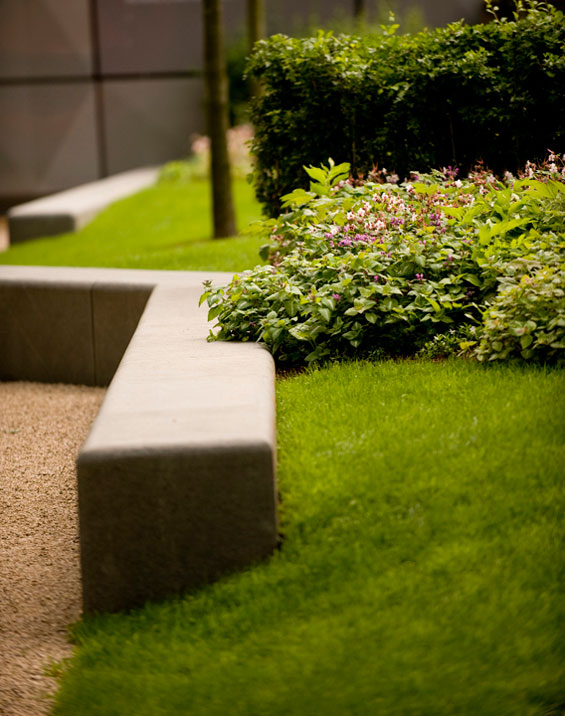
The elegant and peaceful landscaped gardens integrate NEO Bankside with the neighbouring Tate Modern and its surroundings, and provide public access during the day as well as a secure, private environment for residents to enjoy.
At NEO Bankside, Gillespies has designed a series of innovative green spaces that spearhead this movement. The completed designs take cues from natural woodlands and glades, and transpose them to the city. The layout contains large tracts of native plants set within groves of alder and birch trees, providing a ‘bank’ of flowers, seeds and nesting material that will encourage a range of wildlife to the space. Beehives have also been installed, enabling pollination of the plants and helping to safeguard this threatened species.
An orchard of fruiting trees and a herb garden give residents access to produce, encouraging active participation in the management of the gardens. The colour and fragrance of the herb garden adds to sensory delight of the garden areas.
Large forest trees shading cool lawns give residents peaceful spaces in which to withdraw from the world outside. With its diverse and rich range of planting, NEO Bankside’s outdoor spaces uplift the senses, and give residents an opportunity to rest, recreate and retreat from city life.”
We studied the mix and composition of each space carefully. We responded to the challenges created by the particular arrangement of the tall buildings in terms of wind, light and shade in order to ensure that the outdoor spaces have visual-interest throughout the year.
We are delighted that the completed design ensures NEO Bankside’s residents will enjoy quiet seclusion in their own private gardens, while members of the public passing through can also enjoy the wider landscape.”
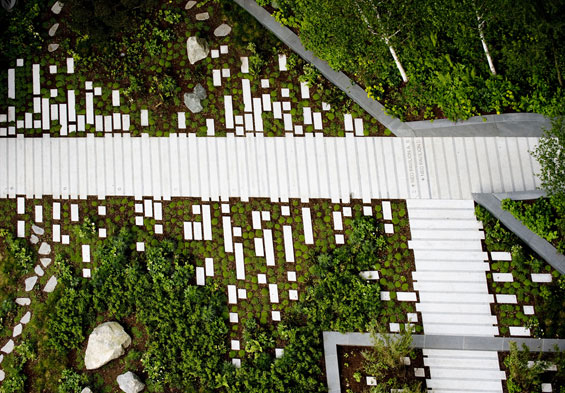
A unique division between public and private space
A significant offer from this project to the wider community is the public permeability through the centre of NEO Bankside. This creates a generous permeable public realm, with landscaped groves defining two clear public routes through the site which extend the existing landscape from the riverside gardens outside Tate Modern through to Southwark Street.
Gillespies’ landscape design was developed to provide optimum private residents’ gardens, while separating them distinctly from the public routes. An innovative landscape strategy was introduced from the outset to define the threshold between private and publically-accessible spaces.
This definition has been achieved through the use of richly-planted berms, pebble-lined moats, stone-lined cuttings and narrow walkways that combine to create a strong sense of identity for the site. The long planted berms are a recurring signature that channel North/ South movement and act as a threshold between private and public space, dissected by a network of residents’ pathways. The berms also complement Tate Modern’s landscape, binding this site into its wider context.
Landscape design was integral from the start
From the outset of the project, NEO Bankside’s developers and design team sought to place the apartment pavilions within a richly landscaped environment, blending private garden spaces with tree-lined linear groves which form the boundary to a new public realm. The designers from Gillespies were brought on board from the early stage, enabling the best possible final outcome.
Distinctive setting and unique planning considerations
NEO Bankside’s four spectacular apartment pavilions are nestled between neighbouring buildings of various ages and styles, including characterful listed Victorian almshouses. This setting meant Gillespies had to design within unique planning considerations. For example, limitations had to be placed on the size of oak trees along the edge of NEO Bankside interfacing with the Victorian Alms Houses in order to filter views. The whole landscape sits on top of a basement car park, and one of the challenges for the Gillespies team was how to allow for sufficient soil for trees and planted areas. A solution was achieved by the design of a folded structural slab that supports the entire landscape above, as well as specialist irrigation systems for the plants.
Sustainability and environmental considerations
Gillespies’ designers placed great importance on selecting the most appropriate materials for NEO Bankside’s landscapes in respect to the environment, place-making and long-term performance. Gillespies specified all elements as suitable for the context, to limit impact on the environment, and where relevant, to be robust and tolerant enough for the stresses of a public environment over a long period of time.
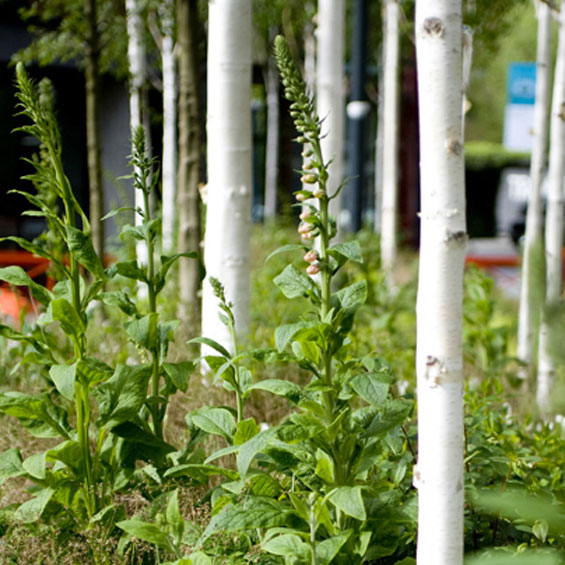
Working with planting specialists Growth Industry, Gillespies included large tracts of native plants into the design, set within groves of trees to provide a ‘bank’ of flowers, seeds and nesting material to encourage biodiversity and a range of wildlife to the space.
Rainwater harvesting for irrigation
Working with Hoare Lea engineers, the scheme evolved to ensure capacity for rainwater harvesting was a central tenet of the basement design and construction. Water retention boards (reservoirs) were laid over the structural slab – this technology provides a reserve of water to maintain soil saturation and consequently limits the amount of irrigation water required. This reserve of water supplements the planting irrigation system, and limits the demands on mains water use.
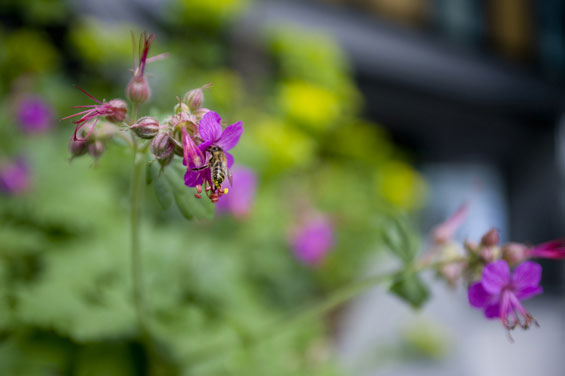
Planting and biodiversity
The planting concepts and final details are central to the overall landscape design for NEO Bankside. The planting softens the built environment, humanises the space and mitigates the local microclimate to create comfortable, welcoming spaces. It also provides a seasonal sense of time and place to enrich urban life. Most of the plants used at NEO Bankside are native in origin and are carefully suited to the microclimate of the site. BREEAM guidelines and biodiversity were a major driver for the selection of appropriate plant species.
NEO Bankside | London UK | Gillespies
Landscape Architect: Gillespies
Gillespies Landscape Design Team Leader: Stephen Richards
Gillespies team members: Armel Mourgue and Oliver Duguid
Specialist planting consultant: Growth Industry
Developers: Native Land and Grosvenor
Architects: Rogers Stirk Harbour + Partners (RSHP)
Main Contractor: Carillion
Landscape Contractor: Frosts Landscape Construction
Engineers: Hoare Lea
AWARDS:
Awards attained by Gillespies for landscape design of NEO Bankside:
International Property Awards 2012: BEST Landscape Architecture, United Kingdom
International Property Awards 2012: BEST Landscape Architecture, London
New Homes and Gardens Awards 2012: GOLD for Best Communal Garden/Landscape
New Homes and Gardens Awards 2012: GOLD for Best Landscaped Urban Development
Images copyright: Gillespies. Photographer: Jason Gairn


Comments are closed.